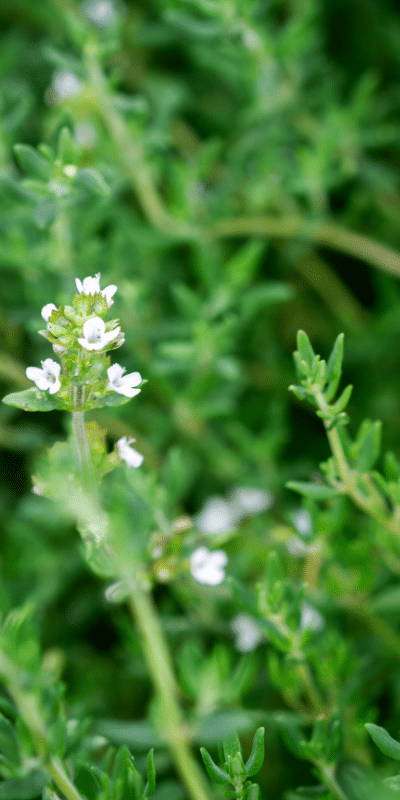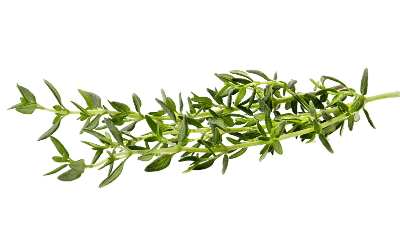
The virtues
of thyme
Thyme or thymus vulgaris is known for its health benefits, and forms the basis for many traditional remedies, for example as an expectorant for coughs brought on by a cold.
Fresh thyme is rich in nutrients! Aside from its 60% water content, it is high in dietary fibre (14 grams of fibre per 100 grams). It is also:
- rich in calcium (405 mg/100g), which contributes to healthy muscles and good skin.
- rich in iron (17.5 mg/100g), which helps maintain normal cognitive function and a healthy immune system.
- rich in magnesium (160 mg/100g), which helps to reduce fatigue, keep muscles working properly and maintain good bone structure.
Thyme also contains large quantities of vitamin C (160 mg/100 g) and beta-carotene or provitamin A (2850 µg/100 g).
Nutritional
values
The right time
to eat it
Thyme can be harvested all year round, but its flavour is most intense in the spring!
Vegetable garden
or city balcony
You don’t need a big garden to grow thyme! If there’s a type of plant that can be grown in a pot on a city balcony, it’s aromatic herbs. In fact, thyme is one of those herbs that can be kept with very little effort.
Thymus vulgaris can be planted in spring or autumn and harvested all year round. It likes light, well-drained soil. Try mixing some gravel into the soil when growing it in a pot. A sunny position is advised.
Choosing
and storing thyme
To choose your thyme, look for leaves that have a fresh green colour, making sure they are not wilted or soft. While its fragrance is strongest in spring, thyme can in fact be harvested all year round. Dried thyme is a common ingredient in the kitchen. It can be kept for up to a year.
There are two ways of drying thyme: the longer method, which preserves maximum flavour, aroma and nutrients, is simply to air-dry it in the sun. You can also oven-dry thyme at 50°C with the door open. Dried leaves can be stored in an airtight container, while bunches of dried thyme can be hung up.
Tips
and tricks
Cooking with thyme
Thyme is the basic element in a bouquet garni (together with bay leaf and parsley), which is ideal for flavouring simmered dishes, sauces or infusions. You can use thyme leaves in stews, sauces, marinades or even in a court bouillon for poaching. It is often paired with lentils, chicken, and apricots.
Did you know? In late spring and summer, from the end of May until October to be precise, small flowers will appear, ranging from white to mauve-pink or even pale blue. Thyme flowers are edible and have a delicate taste.
Thyme can be used to flavour so many dishes it would be a pity to waste!
You can use it in stocks, soups, roasted vegetables… so no need to throw away any old thyme. It may have slightly less taste, but that’s no reason not to use it. You can also use thyme to flavour your honey or drinks!
What is the environmental
impact of thyme?
We can find out more from its PEF (Product Environmental Footprint) score! This is a score established by Agribalyse*. It takes into account every stage in a vegetable’s life cycle: how it’s cultivated, what’s the impact of processing and transport, etc. The lower the score, the less impact it has on the environment.
- Fresh thyme: 0.13
- Dried thyme: 0.4
- Raw beef steak: 2.77
*Figures drawn from the Agribalyse database, which calculates the environmental score of different types of food. This unique score is a weighted average of 16 indicators, calculated according to the European PEF methodology. It does not correspond to an environmental label or ‘eco-score’.
CO2 equivalent: for 100g of fresh thyme, 0.081kg of CO2 eq, or as much as from 2.4g of raw beef steak.

Can everyone eat it?
Mild, non-spicy aromatic herbs can be added to babies’ meals in order to vary tastes and flavours. Thyme is ideal for broadening a child’s range of tastes.
With its mild taste and sweet aroma, many people enjoy thyme. Think of thyme-flavoured broths and stews. Be aware that some varieties of thyme have a stronger, spicier flavour than others!
Where does it come from?
The origins and varieties of thyme
Thyme is native to western and southern Europe, where it can often be found growing wild in rocky landscapes. It is found in the Mediterranean Basin, including in the south of France, where it is sometimes known as farigoule.
There are many varieties of thyme. Some of them are non-comestible, so be careful. The leaves and colour of the flowers can vary according to the variety.
- Lemon thyme
- Common thyme
- Orange thyme
- Thymus officinalis
- Dwarf thyme
- Red thyme
- Thyme tabor
- Summer thyme
- …



 Radishes
Radishes  Peas
Peas  Vegetable garden: growing turnip
Vegetable garden: growing turnip 









